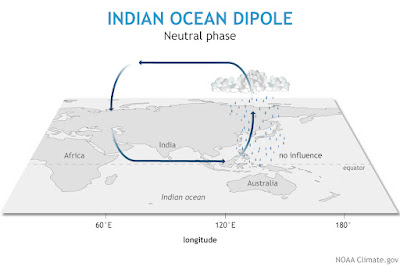Indian Ocean Dipole (IOD) - Explained
Indian Ocean Dipole (IOD)
- The Indian Ocean Dipole (IOD), sometimes referred to as the Indian Nino, is a climatic phenomenon akin to the El Nino event, occurring in a relatively smaller expanse within the Indian Ocean.
- This region is demarcated by the coastlines of Indonesia and Malaysia to the east and the African coast near Somalia to the west.
- The fundamental characteristic of the Indian Ocean Dipole is the disparity in sea surface temperatures between two focal points, akin to a dipole.
- This dipole consists of a western pole situated in the Arabian Sea, which constitutes the western Indian Ocean, and an eastern pole situated to the south of Indonesia, encompassing the eastern Indian Ocean.
- When the Indian Ocean Dipole is in a positive phase, it signifies that the sea surface temperature on the western side of the Indian Ocean, in proximity to the Somali coast, is notably higher compared to the temperatures in the eastern Indian Ocean.
- Conversely, during a negative phase, the western Indian Ocean experiences cooler sea surface temperatures in contrast to the warmer conditions prevailing in the eastern Indian Ocean.
Mechanism:
Positive IOD:
- During the positive phase, the western Indian Ocean becomes significantly warmer than usual, while the eastern Indian Ocean experiences cooler temperatures.
- This temperature gradient sets up a pressure difference, causing the air to rise over the warmer western ocean and creating a low-pressure area, while the cooler eastern ocean experiences higher pressure due to the sinking air.
- This pressure difference drives moisture-laden winds from the Indian Ocean towards Africa, leading to increased rainfall in the eastern African region and drought conditions in parts of Indonesia and Australia.
- During El Nino, the Pacific side of Indonesia is cooler than normal because of which the Indian Ocean side also gets cooler. That helps the development of a positive IOD.
Negative IOD :
- During the negative phase of the IOD, the western Indian Ocean cools down, and the eastern Indian Ocean warms up.
- This reverses the pressure gradient, causing the sinking air over the western ocean and leading to higher pressure, while the eastern ocean experiences rising air and lower pressure.
- This phase can result in reduced rainfall over eastern Africa and increased rainfall in parts of Indonesia and Australia.
Neutral IOD:
India and Indian Ocean Dipole :
- Positive Indian Ocean Dipole (IOD) indices have been observed to counteract the influence of the El Nino-Southern Oscillation (ENSO), leading to heightened Monsoon precipitation during specific ENSO years such as 1983, 1994, and 1997.
- Moreover, research has highlighted that the dual poles of the IOD, situated around Indonesia and off the African coast, autonomously and cumulatively influence the volume of Monsoon rains across the Indian subcontinent.
- In the realm of the Indian Ocean, the interaction within the IOD exhibits a similarity to the oscillations witnessed during El Nino events in the Pacific Ocean. Nonetheless, the IOD wields less potency compared to El Nino, consequently resulting in relatively subdued effects.
- During a positive IOD phase, rainfall augmentation is observed along the African shoreline and the Indian subcontinent, concurrently with a suppression of rainfall over Indonesia, Southeast Asia, and Australia. Conversely, this pattern is reversed during a negative IOD event.
UPSC Previous Year Question (PYQ)
Prelims:
Q.With reference to ‘Indian Ocean Dipole (IOD)’ sometimes mentioned in the news while forecasting Indian monsoon, which of the following statements is/are correct? (2017)
- IOD phenomenon is characterised by a difference in sea surface temperature between tropical Western Indian Ocean and tropical Eastern Pacific Ocean.
- An IOD phenomenon can influence an El Nino’s impact on the monsoon.
Select the correct answer using the code given below:
(a) 1 only
(b) 2 only
(c) Both 1 and 2
(d) Neither 1 nor 2
Answer : Option (b)
Related Articles :







Comments
Post a Comment